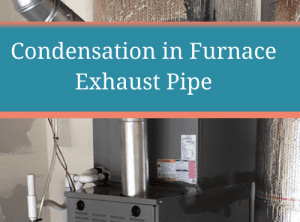Comfort Aire Inc offers the best services of emergency furnace repair of condensation in the furnace exhaust pipe. For more information, you can call (773) 406-7223.
Because your furnace does not require water to run, it can be concerning when you return home to find a puddle of water beneath it. If your furnace is leaking water, this could indicate that something is leaking, dripping, or draining improperly. However, there may be a minor issue. Let’s examine the most typical causes of water leakage from your furnace.

CONDENSATION IN A FURNACE
Are you the proud owner of a high-efficiency furnace? If this is the case, they frequently create condensation. A simple approach to determine whether you have a high-efficiency furnace is to examine the vent pipe; if it is attached with a PVC pipe, you have a high-efficiency furnace. It’ll be helpful if you know timely about condensation in the furnace exhaust pipe.
Condensation from a high-efficiency gas furnace is typically directed through a drain hose to a floor drain. Your leak could be caused by clogged condensation tubing or a clogged floor drain. Chemical tablets and a giant drain pipe can resolve the issue.
If you have a standard-efficiency furnace equipped with a metal pipe, you should never experience condensate leakage. If you notice a leak, it may indicate that the exhaust pipe is too small for your device.
PIPE EXHAUST
The metal exhaust pipe attached to your furnace is intended to collect and remove naturally occurring gases. These gases are designed to depart the exhaust pipe and enter the atmosphere before cooling and condensing into water. If the exhaust pipe is incorrect or does not slope enough upward, the gas does not always reach the outside in time. While the gases are still in the exhaust pipe, they cool and condense into water, resulting in a water leak. Replace or remodel the exhaust pipe with the assistance of a specialist. If you have any problem then contact furnace servicing near me.
PUMP FOR CONDENSATE
Sure furnaces employ a condensate pump to direct condensation to a drain. A condensate pump is a box that is linked to the unit’s PVC drain pipe and pumps water out. If the condensate pump is not functioning correctly or entirely fails, you will see water trickling or overflowing from the device. If you notice water leaking from this location, contact a professional to replace the unit.
HEAT EXCHANGER SECONDARY
The heat exchanger separates the combustion process from the air you breathe in a furnace. Air is heated as it is blown across the heat exchanger’s hot metal surface, and the warm air is subsequently disseminated throughout your home. In other words, a heat exchanger is a necessary component.
Heat exchangers will eventually need to be replaced due to metal fatigue. When metal is heated, it expands, and when it cools, it contracts. Expansion and contraction have the same impact on a heat exchanger as stretching a thin piece of metal has over time—they cause it to break.
Visual observation of water or even light going through the breach indicates the presence of a fracture or hole in the heat exchanger, which must be replaced immediately by a specialist.
HUMIDIFIER FOR FURNACE
If you notice a puddle of water on the outside of your furnace, the humidifier may be malfunctioning. These gadgets help avoid dry air in your home by adding moisture to the warm air pumped into it. However, humidifier problems, such as a clogged drain or filter, might leak the machine. Have an expert inspect the humidifier to determine the source of the leak and repair it.
WATER DRIPPING FROM FURNACE VENT PIPE OUTSIDE
Any homeowner is concerned about water leaks. They can cause considerable structural damage and mould growth if left alone. Even a seemingly insignificant leak, such as water in an HVAC vent, can have grave repercussions. Given that a ceiling vent or air duct can leak water for various reasons, here is a guide to the most typical causes of HVAC vent leaks—and what to do if you detect one.
PROBLEMS WITH CONDENSATE DRAINAGE
If your air conditioning system is located in the attic or on an upper floor, condensate drain difficulties could result in a water overflow from the drip tray. And from there, the water can make its way to the ducts or vents.
The condensate drain system gathers and disposes water extracted from the air during the cooling process. Water will leak from the system if the drip tray leaks or the condensate drain is clogged with algae, dirt, or minerals.
Clean the drip tray and check for leaks to resolve the issue independently. Unclog the condensate drain line with a baking soda-vinegar mixture or a stiff wire.
COIL THAT HAS BEEN FREEZE
An air conditioner’s evaporator coil might freeze on sweltering days, especially in poorly maintained systems. When the power is turned off, and the coil begins to defrost, the ensuing water can overrun the condensate drain, causing it to travel into the ducts or vents of an attic or upper floor system.
When defrosting a coil, keep towels on hand to absorb extra water and clean the condensate drain.
DUCTS OF CONDENSATION IN THE AIR
Condensation can accumulate outside or inside inadequately insulated ducts during both the heating and cooling seasons. This is the most often occurring source of water spilling from HVAC vents.
If you have access to the afflicted ducts in the attic, basement, or crawlspace, you can insulate them using duct insulation or conventional fiberglass taped together.
BOOK AIR CONDITIONING SERVICE IN THE CHICAGO AREA
When it comes to water leaks from HVAC ducts and air vents, it’s advisable to seek assistance from an HVAC professional. A professional can promptly diagnose and correct the issue before it results in significant damage or headaches.
